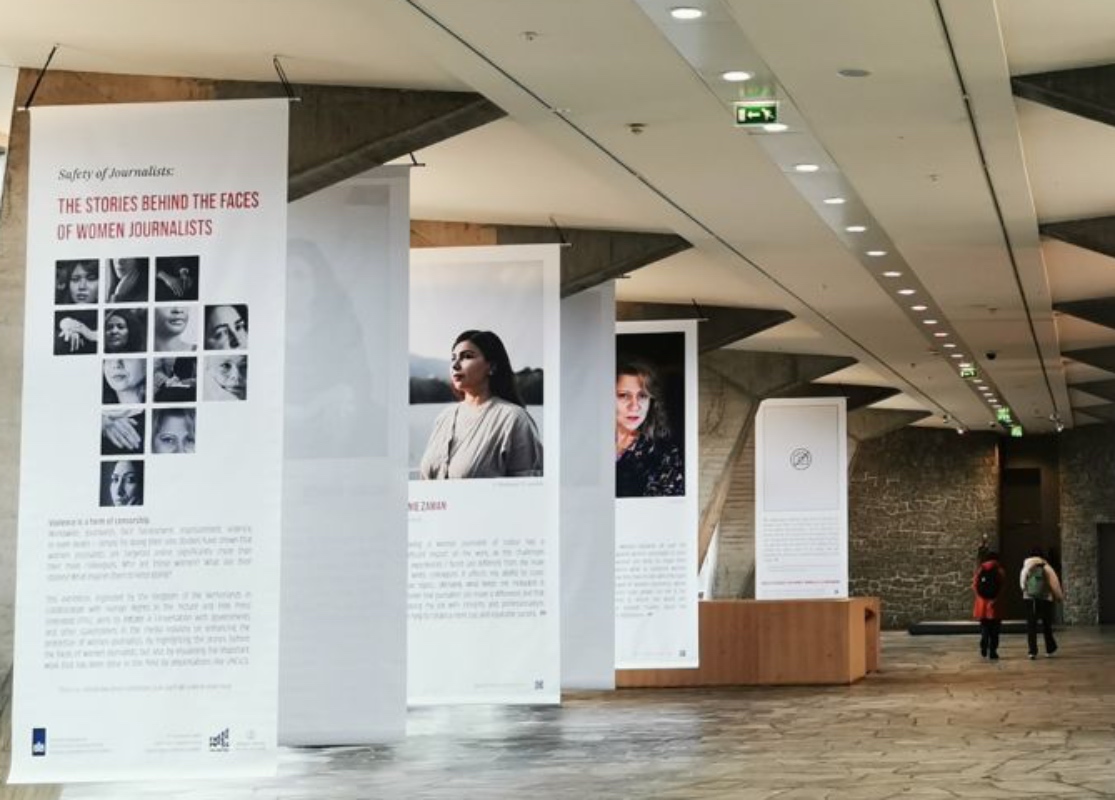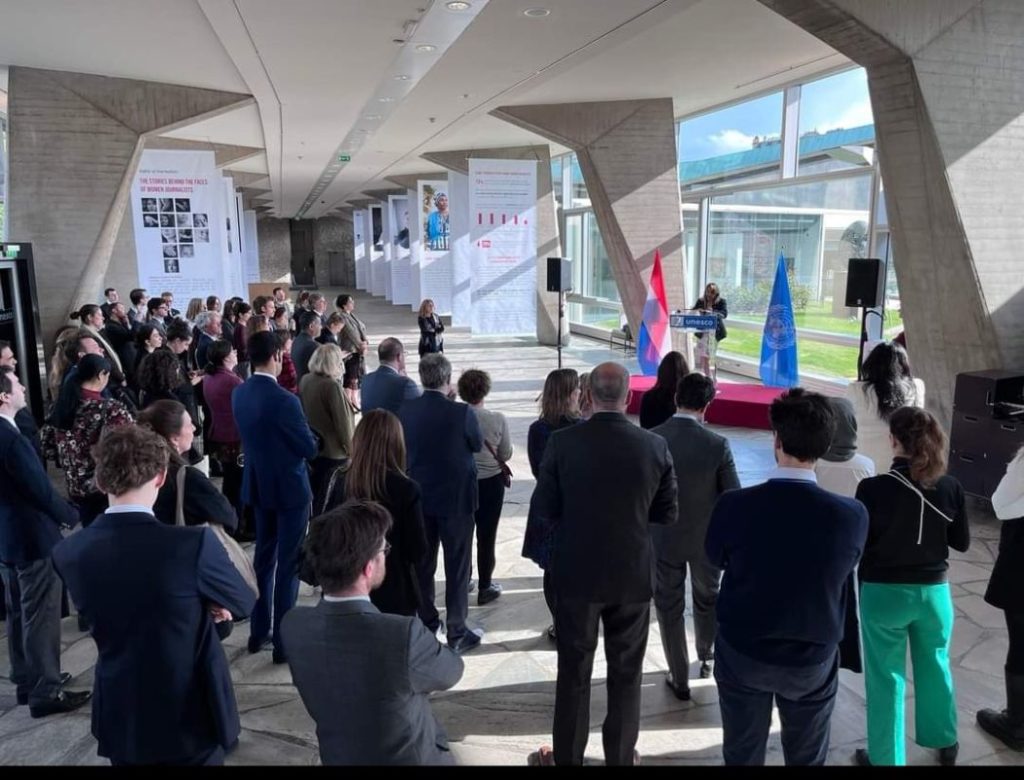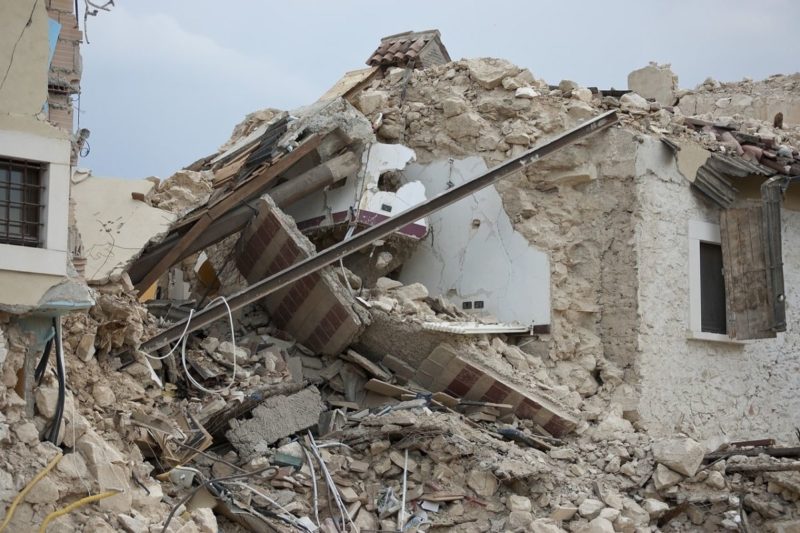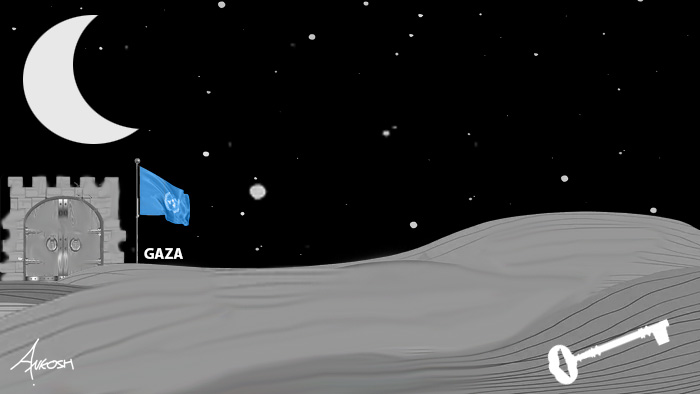Breaking the silence : female journalists on the frontlines of truth and danger

The city of Paris recently hosted a photography exhibition at UNESCO Headquarters that shed light on the perils, threats, and risks faced by female journalists worldwide in their profession. The exhibition, titled "Safety of Journalists: The Stories Behind the Faces of Women Journalists," was presented at the UNESCO headquarters in France a few days ago. It aimed to emphasize that, while violence against women is prevalent globally, violence targeting women journalists is a more serious problem.
The city of Paris recently hosted a photography exhibition at UNESCO Headquarters that shed light on the perils, threats, and risks faced by female journalists worldwide in their profession. The exhibition, titled “Safety of Journalists: The Stories Behind the Faces of Women Journalists,” was presented at the UNESCO headquarters in France a few days ago. It aimed to emphasize that, while violence against women is prevalent globally, violence targeting women journalists is a more serious problem.
Disturbingly, due to the prevalence of (online) violence, one in three female journalists is contemplating quitting the profession, while one in five has experienced offline attacks linked to online “abuse”. The exhibition, curated by the Netherlands mission at UNESCO in collaboration with a number of international bodies and non-governmental organizations, showcased the personal stories of 12 courageous female journalists who have faced security problems in their work. These journalists hail from various countries, including Myanmar, Afghanistan, Morocco/The Netherlands, Curaçao, Pakistan, Azerbaijan, El Salvador, Kenya, Armenia/France, Venezuela, India, and Niger.

Journalists live in constant fear of retaliation, imprisonment, violence, and even death simply for carrying out their duties. There is an alarming connection between censorship and violence. Studies have revealed that female journalists experience significantly higher rates of online harassment than their male counterparts. The exhibition, organized by Free Press Unlimited in partnership with the Kingdom of the Netherlands and Human Rights in the Picture, aims to amplify the voices and experiences of these resilient women.
This impactful photo exhibition was held at UNESCO HQ in Paris and came about through the collaborative efforts of Free Press Unlimited, Human Rights in the Picture, and the Dutch Ministry of Foreign Affairs. “Safety of Journalists: The Faces and Stories Behind Attacks on Women Journalists” explores the profiles of 12 female journalists who have endured threats and violence both online and offline.
“The urgent need for protection and support for female journalists.”
At the exhibition’s inauguration, the Dutch ambassador to UNESCO, Monique van Daalen, representing the United Nations Educational, Scientific, and Cultural Organization (UNESCO) in Paris, emphasized the courage needed to address uncomfortable truths without fearing the consequences. In her speech, the ambassador highlighted the risks faced by journalists worldwide, particularly female journalists, and expressed gratitude to the 12 reporters who bravely shared their stories. As she pointed out, some of those reporters have remained faceless due to security concerns – a global phenomenon.
The exhibition serves as a powerful reminder of the invaluable contributions of journalists who persist in the face of threats and violence, both in their online and daily lives. It seeks to raise awareness and spark conversations about the urgent need for protection and support for female journalists.
During the event, the ambassador acknowledged the courageous presence of Lailuma Sadid, a journalist from Afghanistan, who fearlessly shared her own experiences and shed light on the challenges faced by women in her country, especially those who work to inform the public.
“Three Ps: protection, prevention, and prosecution of crimes.”
Guilherme Canela, the head of UNESCO’s Division for Freedom of Expression and the Safety of Journalists, outlined the initiatives taken to address these challenges in the field. He emphasized a plan that was set in motion a decade ago, with the support of UNESCO, other UN organizations, member states, and civil society. Canela stressed the importance of using the “three Ps”: protection, prevention, and prosecution of crimes as a framework for combating violence against journalists and ensuring accountability.
Canela highlighted the fact that discussions within the multilateral organization frequently raise concerns about the vulnerability of female journalists and the urgent need for additional measures to ensure their safety globally.
A press release from Free Press Unlimited, received via email, announced their commitment to promoting a secure environment for all women in the media. Their Reporters Respond Fund provides immediate aid, psychosocial counseling, and legal support to women who have been attacked. Additionally, their Policy and Advocacy team advocates for improved legislation to prevent online violence, urging policymakers to prioritize this issue.
The press release also mentioned the Kingdom of the Netherlands’ intention to initiate discussions with governments and stakeholders in the media sector to enhance the protection of female journalists. They are collaborating with Human Rights in the Picture and Free Press Unlimited (FPU) to highlight the stories behind the faces of women journalists and showcase the significant progress made by organizations in this field.
It is disheartening that many female journalists continue to be targeted with (online) assaults, which are rooted in gender-based discrimination, and assaults, which are rooted in gender-based discrimination and are both sexist and misogynistic. These attacks range from offensive messages and rape threats to physical assaults, causing severe psychological trauma, stress, and isolation. The impact of this (online) abuse extends to physical pain and even self-censorship. This has a direct influence impede press freedom by limiting diversity in news coverage and obstructing important information from reaching a wider audience, as emphasized in the FPU’s press release.
“If they faced such hardships, who am I to complain? I, Samira.”
During my visit to the UNESCO office in Paris for the photo exhibition, I had the opportunity to meet Ms. Samira Sabou, a journalist from Nigeria, who has shared her story. In our conversation, she described her experiences and the challenges she faces in her line of work. When asked about the pressure and threats she encounters, she responded with a thought-provoking perspective. She explained that prophets in history who spoke of peace, tolerance, love, and respect for others were mistreated, insulted, and even killed. Drawing inspiration from their stories, she finds the strength to face adversity and refrain from complaining. She stated, “If they faced such hardships, who am I to complain? I, Samira.”
Samira also highlighted the intense internet abuse she endures, particularly due to intimidation and threats from certain intellectual factions that oppose her truthful reporting on the military presence and Western objectives in the Sahel region. Although she favors readjustments in international relationships and interests, she emphasized her commitment to journalistic ethics and responsibility and her refusal to convey false content.
When asked about how her story can motivate other female journalists, Samira emphasized the importance of compassion and human solidarity. She believed that exhibitions like the one at the prestigious UNESCO Hall serve as constant reminders that pursuing an ideal is a collective effort, and no one is alone in their journey.
In her plea to policymakers, Samira urged them to support the rule of law and regulate online journalism in Niger, her native country. She highlighted the authoritarian abuses facilitated by the absence of such regulations.
“Even attempted kissing while waiting alone to go live.”
Another journalist I encountered at the exhibition was Astrig Agopian, an Armenian journalist based in France. She talked about the unique challenges faced by female journalists working in conflict zones, where they are often not taken seriously. Astrig revealed instances of inappropriate touching, interruptions during recordings, and even attempted kissing while waiting alone to go live. She also received late-night contacts and inappropriate texts when she provided her number to men for professional reasons related to reporting or security.
Astrig further revealed the barrage of internet comments and emails containing insults, references, and death threats targeting her because of her gender. The toll that female journalists pay for merely carrying out their duties is staggering, affecting their mental health and, in some cases, resulting in tragic consequences.
Despite these challenges, Astrig expressed her deep love for journalism and its importance. Over the past three years, she has covered the effects of wars in Armenia and Ukraine, realizing the significance of giving a voice to people affected by conflicts. She finds inspiration in this work and remains committed to shedding light on important stories.
These conversations with Samira Sabou and Astrig Agopian provided profound insights into the struggles and resilience of female journalists in the face of adversity, underscoring the importance of solidarity and the need for greater support and protection in their profession.
The president of the European Parliament Roberta Metsola emphasized the need for journalists to be allowed to carry out their duties without fear on World Press Freedom Day. Their freedom, safety, and quality of life are crucial.
She declared that using violence against journalists is a red line that should never be crossed.
During the plenary session of the European parliament in Strasburg members of the EU In accordance with a 2021 Court of Justice judgment, MEPs request that the European Union ratify the Convention on preventing and combatting violence against women.
The Istanbul Convention continues to be the international standard and a crucial tool in the fight against gender-based violence, including domestic violence, according to the text, which was accepted with 469 votes in favor, 104 votes against, and 55 abstentions.





